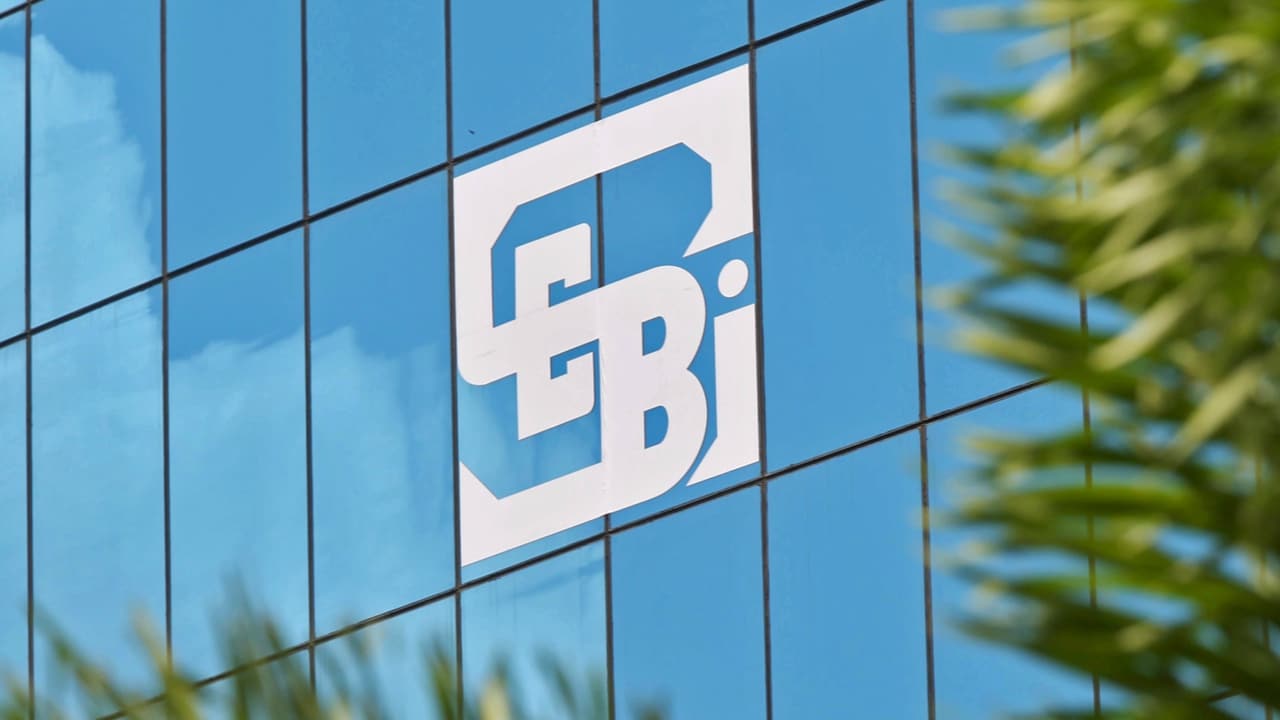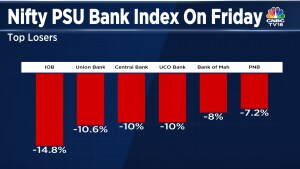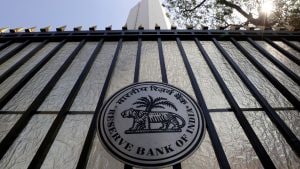Market Cafe: Gautam Duggad and CNBC-TV18’s Surabhi Upadhyay discuss markets after elections, stocks and much more
Summary
In this premiere episode of Market Cafe, Equity Research Analyst Gautam Duggad and CNBC-TV18’s Surabhi Upadhyay discuss interesting points from election data going back all the way to 1999. Duggad shares details of the 2007-2008 “bull run”, apart from decoding some keenly observed sectors and highlights certain stocks.
Hi there. I’m Surabhi Upadhyay and I’m a markets host with CNBC TV18. Now, usually you will find me in the studios as we track the ups and downs of the stock market, the daily roller coaster. Today, however, I am not in the studio, I am in the CNBC-TV18 markets cafe. This is a brand-new digital offering, where I’m planning to have some interesting conversations over coffee, it promises to be something really refreshing and interesting. So thank you all for tuning into our first inaugural show. Let me now introduce my very first guest. Today joining me on the CNBC-TV18 Markets Cafe is Gautam Duggad, who’s the Head of Research at Motilal Oswal Institutional Equities. Gautam, thank you very much for coming in. And welcome to the Markets Cafe.
Here are unedited excerpts from the Market Cafe show:
Gautam Duggad: Thank you so much for having me.
Surabhi Upadhyay: Usually, we sit you down in the studio, then we start asking you what’s happening with earnings season where is the nifty going? But today with all you know, take it a little easy. So, first things first, it’s the market cafe show to pehle to app ye bataiye, what will you like to drink? Tea or Coffee? We have some coffee. Okay, great. So can we have two coffees please.
Gautam Duggad: Yeah, not so long actually its middle of the day, still.
Surabhi Upadhyay: Middle of the day, the markets shut in the middle of the day for you, middle of the day and you know right now we’re having this conversation, is just after about four o’clock in the evening. All the glamour that we see all the money in the razzmatazz, I guess a lot of hard work goes in.
Gautam Duggad: Because a lot of things move behind that price sticker.
Surabhi Upadhyay: Behind that price sticker which we track the ups and downs and all of that. Phenomenal. So, before we get started, I want our viewers to know a little more about you. Now for you know, all these years over a decade and a half that I’ve been tracking markets with CNBC-TV18, Gautam has been our go to person whenever there are big moves in corporate earnings, whether you know, sectors or something changing in policy, we rush to him and ask him for help. It’s been a long time at Motilal Oswal for you, right? Yeah Surabhi, actually I completed 11 years just last week with Motilal Oswal. Oh, congratulations, long stint. And how long in the equity markets before that? You were working with a couple of FMCG companies?
Gautam Duggad: No. So I worked with only one. So, I started my career with Procter and Gamble. So that was my first job. From 2005-07, after which I finished my studies from IIM, Calcutta. Okay. And then 2007, August is when the market bug took over me. Right in the middle of the bull run of 2007-08. Yeah, how can we forget. So now almost 16 years into the market, 16 years, you can say first eight years, I tracked consumers and analysts. And last eight years, I’ve been head of research and strategist. Still like it? So yeah, I mean 50-50, basically, sector and strategy both. So I now handle head of research responsibilities, and also write on strategy and do a lot of team related responsibilities.
Surabhi Upadhyay: Okay, fantastic. Fantastic. Well, why don’t you get your coffee? Yeah, that’s fine. We’ll get going. Perfect. Thank you. So, Gautam one of the reasons we thought we want to have a different conversation with you today is that there’s this growing buzz in the market in terms of what next? What’s the next trigger or aage kya aane vala hai? Everybody is now beginning to talk about elections. Some activity has started, we started seeing some policy changes, LPG prices, for instance, 200 rupay ka cut aa chuka hai vaha pe. And I think increasingly, people want to know whether this buzz will increase and whether you need to start looking at your own portfolio differently. So that’s one of the main reasons we thought we want to sit you down and try and understand that. So first basic question, what do you think? Is there a clear correlation between elections in the country and the stock market?
Gautam Duggad: Oh, definitely. There is in the short term, definitely, there is a big correlation. Because the election is such a big policy event for markets. Elections decide the outcome of who’s going to run the government, which in turn decides how the economic and function because different parties have different economic ideologies, right, whether you have a stable coalition, whether you have an you know, very fragmented coalition or you have a single party majority, that has a significant implication on how the economic functions hold the policy momentum for the economics, and ultimately market is a subset of the economy. So, I am a firm believer that from a short to medium point of view, or term point of view, you have elections, which is a very important event. However, if you are looking at the market from a very long-term picture, say 10-15 years, then obviously elections come and go, then the only thing that matters is your corporate earnings because that’s the single largest driver of the market.
Surabhi Upadhyay: As long as companies make money, yes, stock prices move higher. And it’s just a no brainer.
Gautam Duggad: I mean, you’ve seen that happen already for last 10-15 years. So many events have happened politically geopolitically crude going up and down governments changing multiple times, right. But look at it this way 2010-20, and this my favorite date of point. Nifty gave you a return of eight and a half percent compounding 2010 to 2020, 10-year period whole 10-year period. At that point in time, the corporate earnings corresponded to just six and a half percent. 2022-23 FY22 and FY23, markets have given you 27% CAGR, which has been a phenomenal period for the market, backed by equally phenomenal earnings of 23%.
Surabhi Upadhyay: And imagine coming out of COVID, when it seemed like the world is ending, we came back with a bang.
Gautam Duggad: Yeah so, over a very long period, has broadly tracked earnings in between lots of things, drive the markets on a day to day, quarter to quarter, month to month basis for politics, you know, how the commodities or how the interest rate or what FED is doing.
Surabhi Upadhyay: And elections is one of those those kinds of triggers? That’s a very big, it’s a very short term, very big event. You know, I was reading a pretty interesting piece of research written by Chetan Ahya of Morgan Stanley, and he’s one of their key strategists. Now, he is doing some research for the US market. He went back, I think saw data over 100 years to figure out how the US market reacts to elections if there’s a correlation there or not. Now, interestingly, his thesis is that, at least in the US, stock markets are not partial to any party. I mean, sure, there was some, you know, data that came up that I think stock markets over the over 150-year period, they rose more when Democrats were in power than then Republicans were. But I think the point that he was making, at least with that market, is that it’s not so much about which political ideology. But there, there was an interesting trend that whenever the incumbent government was continuing, Marcus kind of ambled along and have lost some momentum. And wherever challenger was coming into power with some interesting fresh ideas, the US market had little more kind of momentum coming in, is there any correlation between ideologies at all? I mean, does that even matter? I mean, how does the market read a change in government or, you know, a change in the political system dispensation?
Gautam Duggad: So, it’s very contextual, Surabhi. Because we are talking at this point of time where we’ve had 10 years of a single party majority government, yeah, after, like, 25 years. 1989 was the last time we had a single party majority. After that, there was a 25 years of coalition era, right? Then 2014 till now, we’ve had, again, two consecutive terms of a single party majority government. So in our case, the conclusion and therefore, the understanding, you have to always keep the context in mind, right? Because we came to 2014, after a period of a very, very subdued macro, you can say, there was termslike policy paralysis were being used. Yeah, there’s a lot of issues on the governance, corruption and all of that. Right. So coming from that background, we actually had a single party majority government. Last seven, eight years, you’ve seen multitude of reforms, really big picture reform, no GST, radar, IBC and payments revolution, digital infra physical infra. So at this point of time, I think markets will value continuity, having, you know, another term for a majority single party government, that will, that is something which market will really value. But going into the past, I mean, because I was looking at some data points, look at the last five elections from 1999 till 2019. Right, so almost 25 years, right. Five different elections. And if you look at the data for markets, just six months before the election, that is the day of counting and announcing of results. Okay, right. So if the results are going to be in same May 24, you will look at it from number 23 to May 24. Sure. You go backwards. Last five such elections 1999, 2004, 2009, 2014 and 2019, every six months prior to election market has rallied.
Gautam Duggad: That is why we have you here because we’re just at that phase, right, six, seven months before the Magnitute of rally has been very different. Okay. So if you look at 1999 till 2004 or the 1999 election from you can say May 1999 till October 1999 because that time elections happened in October 1999. Right. Markets rallied 36%. In 1999 36%. Okay. 2004 the market rallied just about 10% before the results.
Surabhi Upadhyay: And 2004 was though I mean, I was also looking at immediate reactions on the day before the day.
Gautam Duggad: We are talking just before the election.
Surabhi Upadhyay: And that was the India shining period. Yeah.
Gautam Duggad: 2003 October or November till May 2004 markets rally 9-10%. Okay. 2009 you had a huge 31 or 32% kind of rally. Right. Then 2014 again, you had a 20% rally from September or maybe November till again May. Yes,and 2019 you had a 10% or 11% rally. Okay, so five consecutive elections from 1999 till 2019 markets have always rallied six months into the election counting on the day of announcement.
Surabhi Upadhyay: Okay, so, Gautam, this is really, really interesting what you’re telling us that at least in the last five election cycles, the market has rallied going into the event, at least six months, 6 months se rally basically shuru ho jaati hai, which is good, because we have you at the right time, because now I can ask you how to start preparing for this rally.
Gautam Duggad: So, the last five instances have been very clear, you got rally, ranging from 9-10% to about 36% way back in 1999. 2009 I would also categorize as a very unique year because there was a year when elections also coincided with the recovery that we saw from the GFC crisis of 2008. Right, we I think bottomed out somewhere around October 8, you know, Sensex was some 7000-8000, 8000 I think, if I remember well and market started rallying after that, and that period also coincided with that pre six months to the elections period. And it continued after the election because the UPA government got the majority in 2009, market hit a upper circuit of 20% after the election.
Surabhi Upadhyay: I remember that yeah. Because I think that was the period where the election result was announced over the weekend market came back with a bang. Yes. And that Monday was like it was just completely insane buying happening on that Monday. So yeah, 2009 was pretty historic in terms of the reaction that the market had to elections.
Gautam Duggad: Yes. And then it continued, because you got some 31% rally six months before the 2009 elections. If you look at six months later, the markets rallied another 36%. So that is a very unique year, because it also was the year where entire global markets rallied after, you know, the 2008 correction.
Surabhi Upadhyay: Because we were coming out from you know, the mother of all financial sizes. Absolutely. 2008. Yeah. And then there was a period of recovery.
Gautam Duggad: But rest of the period, you know the other four periods, six months after elections, you got very muted returns. Like it wasn’t for after six months, the market was up 8-9 percent. In 2014, about 15-16 percent. Okay, there’s a major change in power. The 2019 markets were flat six months later.
Surabhi Upadhyay: Because it was continuity to get considerably Yes, same government continuing with the policy. So, the market wasn’t too excited from a political and from policy.
Gautam Duggad: It is just continuity, market digested the election results quickly and moved on from them.
Surabhi Upadhyay: Basic sort of thing to ask here is that now that you’ve told us that history is proving that typically there are rallies going into the election, so it’s only logical, right that we need to check our portfolio, maybe make some tweaks, maybe add some of the hot sectors, would you agree?
Gautam Duggad: No, I won’t agree because Surabhi this year 2023 particularly, the mid cap and small cap indices are already up 25-26% YTD you know from January till September. So it’s not as if that we’ve not rallied, we’ve already rallied especially mid cap and small cap. Nifty, Sensex, they’ve been relatively more subdued, relatively the valuations are also more attractive in large caps today. Your mid cap index is trading at a 15% premium, right and mid cap, you can see lots of subspaces categories, sub segments, they’ve heated up a lot. Now there are stocks which have rallied 60 100 200% In a matter of eight, nine months. So I would rather say and categorize it a bit differently, that if you’re looking at the period going into the elections, then probably large caps today offer a much better risk reward purely on valuation basis.
Surabhi Upadhyay: So, I just want to give you a sample of questions coming in. It’ll give you a sense of the excitement out there on social media as well. Right. Viraj Joshi is saying which Indian companies will benefit more from elections. How do I build my portfolio. Priyesh is saying do stocks like Pratap snacks or Patanjali foods, FMCG in general, does this sector benefit ahead of elections? Heeren is saying should one be buying more paper this is interesting of paper or media stocks? Because the amount of advertising, political advertising tends to go up at a common sensical question. So you know, our viewers are pretty excited. So help us wrap our heads around this what to buy before the election.
Gautam Duggad: See, Surabhi basically your sectors are not so dependent on elections. You will have some a few months here & there, elections decide the fortune on sector. First, you should not build a portfolio for lectures. Okay, you should have a portfolio before elections and after elections too. Absolutely. Maybe you can make some tweaks here and there, depending on the spending of different sectors. Okay. So typically, if you notice, going into the election, governments are always very hyperactive on spending, be it infra or be it consumption, because they always want the consumer sentiments to be upbeat. Right? Right. Infrastructure has been recovering after a long time, I mean, to say, the capex cycle. Correct. You know, the private capex cycle, which has been very subdued, for large part of the last seven, eight years, started recovering in the last 1218 months, and which is why you’ve seen industrial stocks, you know, stocks belonging to the infrastructure, capital goods, defense, those areas, they’ve already done phenomenally well, in the last 12-18 months. So, I wouldn’t really hazard a guess as to which sector you should zero down on, and then, you know, a market with the election brush, that this is a sector for election, and this is a sector for perpetual, you know, sort of portfolio. I wouldn’t do that. Okay. Yes, at the margin, you can say some of the interest bending will get accelerated as you head into the election season. Also, remember the fact that there are four state elections in November and December? Yes. Right. We’ll also see lots of spending from the government as well as candidates who are fighting those elections. So, a lot of money gets spent in all these elections, which ultimately trickles down to the bottom of the pyramid. Yeah, right. And we’ve seen in the past because the election spending, after some lag, you generally see consumption picking up. So infrastructure, consumption, these are two broad buckets, where I would sort of say, elections generally benefit. And then you have financials, which are already on a roll, you know, banking has been bit subdued. But do remember that in terms of corporate earnings, the banking financials NBFC and non-lending stocks have already done really well in the last four or five years. This year. Also, they’re expected to do well on earnings.
Surabhi Upadhyay: You know, I want to come back to that point on capital goods. And I was looking at more questions that were coming in on social media, and Deepak Kishan and he really sums it up, I think, for everybody. And he’s saying the same thing that capital goods manufacturing has been the space to be in, but the question is, now that the rally has already happened, should we actually start booking profits before elections or can you still add to positions by more at least hold positions, like you mentioned, I mean, the stocks have gone completely crazy. So what to do,
Gautam Duggad: So here, you must be very bottoms-up, you cannot paint the entire sector with the same brush, there is a possibility that even in a sector, which has rallied so much, there might be few stocks, where the risk reward is still looking February, okay. But if the stock has already run ahead of its fundamentals, right, relating has been phenomenal, and you feel that the earnings are not matching with that, then maybe you should, you know, take out your money and re-deploy it somewhere else. Okay. But I would say that look at it from a bottoms-up perspective. First, sector to sector and then within sector also, because the returns of different companies within sectors have also been very different. It’s not that a sector has given 10 percent return. That doesn’t mean that every company in that sector has given similar to their companies which would have given 50 percent and equally there will be companies which would have given -20 percent.
Surabhi Upadhyay: So, which ones in this bucket in this basket of Capex industrials? Which ones do you like the most?
Gautam Duggad: So, my preference is towards the core capital goods companies, because that is where you’re seeing the emergence of cycle after a long time. In fact, in India, right now, very interesting things happening in markets, there are five or six sectors that domestic cyclicals facing, they are having an upcycle at the same time, almost after a long time. Right. So, number one is capital goods or broad private capex or capex, industrial sector? After 12 years, then you have auto where there is an upcycled going on after five years, between 2018 to 2023 when the financials profit went up 5x, the auto profits were same. Right. So auto is seeing a cycle after five years. Then there is the hotels sector, which is seeing a cycle after 10 years.
Surabhi Upadhyay: And we know that as consumers will never find reasonably priced hotel rooms anymore.
Gautam Duggad: Then real estate again after a decade, you’re seeing an upcycle. Yes. And last but not the least is hospitals where there was no cycle which I can remember of because there were not many companies to play also in that space. You’ve seen a lot of new listings happening in the last four or five years. In fact, in our conference, which we just concluded a fortnight back 90s annual global conference, we had two main tracks in your speakers from hospital space. So there’s a four or five sectors where you’re seeing domestic cyclical tailwinds.
Surabhi Upadhyay: Hotels, industrials, auto and real estate. That’s really powerful. Right, five big themes, big sectors, which are on an upswing, yeah, and obviously that that brings a lot of momentum with it. So, we discussed industrials. Now let’s talk about you know, another element which I think people will start worrying about. Ah, let’s see. Let’s talk about the LPG price cut, right? We had that 200 rupees cut coming in on cylinders. a. What’s your view on the on the sector on some of these oil marketing companies? And b. Is there a real worry that we’ll keep getting more of these populist measures which make junta happy? Well, let’s face it, it makes you and me also very happy, right? Whether it’s tax changes, more freebies, and if that starts happening, will that be bad for the market?
Gautam Duggad: So two different questions. The view on the sector, I’ve generally stayed away from the sector because very difficult to predict earnings there. Plus there is lot of government involvement. And there’s low volatility because they don’t have pricing power. Coming to the second question, which is the giveaways or handouts, the quantum is what is going to decide the reaction of the market, okay, it’s a once in a while 200 rupees here or there, see, look at it this way, the inflation has also gone up a little bit. We’ve been upwards of five and a half percent for some time. And in an election year, any narrative around inflation makes a huge difference.
Surabhi Upadhyay: Rs 200 tomatoes.
Gautam Duggad: But inflation and news around inflation, and how it is perceived, is always very, very critical and sensitive, or more from the point of view of incumbent. This government has drawn a lot of praise on their fiscal management. Yeah, they’ve been very consistent and credible in terms of the overall managing the deficit, the arithmetic of the budget has become far more credible in the last six, seven years. You know, earlier, they were always very, I remember, in earlier days after the budget people always used to ask a lot of question, whether it’s Math is believable or not. Right. So those questions have stopped. Therefore, government also needs to remember that what they’re doing is also going to have an implication on their reputation as far as fiscal rectitude is concerned. So, I am not going to get too worried about one of these majors getting an hour. But remains to be seen because we are still eight months away from the elections.
Surabhi Upadhyay: Got it, I think, we need to basically watch out for the way these handouts and freebies, you know, if at all they come and what is their size? If it’s big, then it could be a problem for the market, as long as it’s usual, what we see every election year.
Gautam Duggad: Because you remember the size of our balance sheet. I’m talking about the central government, it’s gone up to 44-45 lakh crores now, the total expenditure. Right. So if your total spending on all freebies, giveaways, whatever promises you’re doing is a minuscule percentage of your total budget total expenditure it’s fine. I will not get disturbed by the size in terms of the quantum. So when I say quantum, I basically mean as a percentage of that state’s balance sheet. Yeah. And not the absolute number
Surabhi Upadhyay: Not the absolute number as long as it’s a percentage of your total, you know, size your balance sheet as you’re saying as long as that remains in tact it will be okay. Got that Gautam. So now sum it up for us. And you got to give us some election stocks, right? I mean, I’m calling them election stocks, because like we discussed maybe for the next seven eight months, they could benefit from the sentiment from the momentum. So, if you were to name two or three ones, which are good election stocks and also good stocks, otherwise absolute which ones would they be?
Gautam Duggad: So Surabhi if you look at our model portfolio, some of those stocks are already present there. Okay. So, we are quite positive on capex and auto. Okay. And I think given where interest rates are given where the policy momentum is on manufacturing infrastructure, the whole capex team they can continue to do well if there is a continuity in the government formation, right. So we have say for example, stocks like L&T, the big weight, stocks like Ultratech Godrej Properties, you know, even SBI for that matter, SBI & ICICIC because in a very indirect way, they also benefit from the higher capex spending that happens, they will fund those big expansion that so that is the manufacturing side and Capex side. On the consumption side, we are heavily overweight. Okay. We have the highest overweight on consumption. We have about 19% weight allocated to consumption stock.
Surabhi Upadhyay: And that’s what kind of consumption? The toothpaste or the movies and hotels? The descreationaries
Gautam Duggad: So, our single largest preference for a very long period of time for last eight, nine years has been tightened. So that’s part of the model portfolio. Then we have both the hotel stocks in the model portfolio, Indian hotel inventory, we have Zomato, which we added about a couple of months back, right. Then we have Kazaria, Metro and on the stable side, we have ITC and Godrej. So about 7-8 stocks, which together comprise about 19% of the way okay, and then the usual you know, big part of the weight in any model portfolio will always find allocated towards financials. Within financial we have one difference, which is that we have a big overweight on PSU banks. Okay, there’s relatively neutral on private banks. Right, so our big over-weight is on SBI and Bank of Baroda and climate banks are neutralish. And then we have a chunk of NBFC stocks where we are quite positive. For names like Bajaj Finance, Mahindra Financial, Piramal they dominate our portfolio. And last but not least, is auto as I keep telling you, that auto has turned around and turn around in a very, you know, strong fashion. And after 16 consecutive quarters of earnings downgrade, last three quarters, you’ve seen upgrades. Right, right. And this quarter again, auto was the best performing sector on earnings. So we have big over-weight there. Your stocks like M&M, Ashok Leyland, Bharat Forge, and Craftsman.
Surabhi Upadhyay: So that’s the overall portfolio, but I’m gonna ask my question again, now give me three or maybe four stocks, okay, which are like, probably good plays elections being one big trigger, but next six months, you think from this whole big portfolio, the three or four that you’d really watch out for that so that you think will do well?
Gautam Duggad: L&T. Secondly Titan and the third will be UltraTech. UltraTech is very interesting as they, together broadly represent your capex plus industrial, less consumption.
Surabhi Upadhyay: I was at a Titan store, I think last week or something the way I see the crowds there, and the festive season hasn’t even begun just yet.
Gautam Duggad: I think reflected in the numbers also. It is one of the few consumer companies, which consistently grows top line at 20%. Right, whereas most of the other consumer company staples, if you look at the last 5-10 year, compounding, the top line has not crossed 10%, hardly one or two companies have grown their top line at 10 percent.
Surabhi Upadhyay: Imagine people are buying jewellery, probably at a higher rate than their buying.
Gautam Duggad: It’s a classic income effect. Right?
Surabhi Upadhyay: Well, so far, we’ve discussed so much of business and work, but I want to know more about what you do. Do you get time at all, considering, you know, four o’clock is a midafternoon for you? So, what do you do to relax after work?
Gautam Duggad: So, I’ve read about politics a lot. That’s an aftermarkets hobby.
Surabhi Upadhyay: No wonder you know, all these trends, like the back of your hand, on elections and politics.
Gautam Duggad: I like reading and listening to a lot of things around politics of the past also, and other current also. I spent a lot of time these days last two, three years post COVID, browsing through the OTT.
Surabhi Upadhyay: You are a huge OTT buff, I remember our conversations, where Gautam will always know the latest things to watch and you know, the hottest trends on OTT consumption.
Gautam Duggad: That I started post Covid when I was at home and there are very little avenues to sort of de-stress. What are you watching these days? So I finished this latest one, which is come, Taali
Surabhi Upadhyay: Yeah, I’m reckoning where I have seen that. I feel good. Yeah.
Gautam Duggad: The one on Sony also, Trial. Okay. Dahaad on Amazon, I think. And couple of I think they released some short movie on Amazon two days back. Okay.
Surabhi Upadhyay: So, whether it’s market trend or corporate earnings, or politics or the latest on OTT, fantastic. You manage it all. Phenomenal, phenomenal. Well, Gautam its been an absolute pleasure. Thank you so much for taking the time and having this cup of coffee with me and I think this was a very, very good conversation. Really enjoyed it. My pleasure. Thank you very much. And see you again, I’m sure you will. We’ll have you more often in the cafe, not just in the studios. See you again soon.

Elon Musk forms several ‘X Holdings’ companies to fund potential Twitter buyout
3 Mins Read
Thursday’s filing dispelled some doubts, though Musk still has work to do. He and his advisers will spend the coming days vetting potential investors for the equity portion of his offer, according to people familiar with the matter









 Listen to the Article
Listen to the Article  Daily Newsletter
Daily Newsletter
















